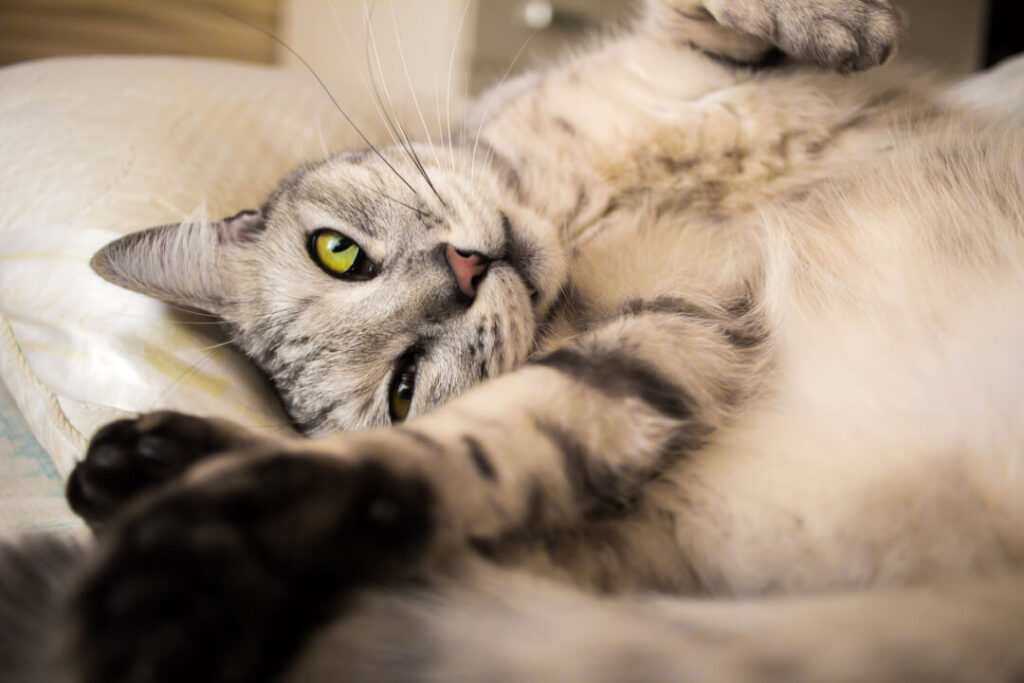Do you have an elderly cat at home? What do you need to know about older cats and what do they need as they age?
Every day we get a little bit older. That’s life: we are born, learn to live and then we say goodbye to this world.
Cats too.
Only it all goes a little bit faster with them! Kittens are born after a shorter gestation period and are full grown cats in no time, with everything that goes with it. They are totally ready for life and after a certain time they completely cut their ties with their mother. Some human babies never make it! In retirement, they still live with mum and dad.
It’s more or less impossible to say how long a cat lives. It depends on many different factors. But their life cycle is usually shorter than that of humans.
When is a cat elderly?
Creme Puff, born 3rd August 1967 in Austin Texas where she died on 6th August 2005, holds the record. This American domestic cat reached a biblical age of 38 years and three days! And with it entered the Guinness Book of Records as the oldest cat ever recorded.
One of Creme Puff’s forerunners, “Grandpa”, lived up to his name, reaching 34 years and 2 months! But these are the golden-oldies of senior cats.
On average, cats don’t get quite as old – more like 15 years. (Of course many exceptions disprove this rule.)
To understand a cat’s age in terms of how we calculate time, we used to think that one cat year was the equivalent to seven human years. Now we estimate that the cat’s first year is 15 human years:
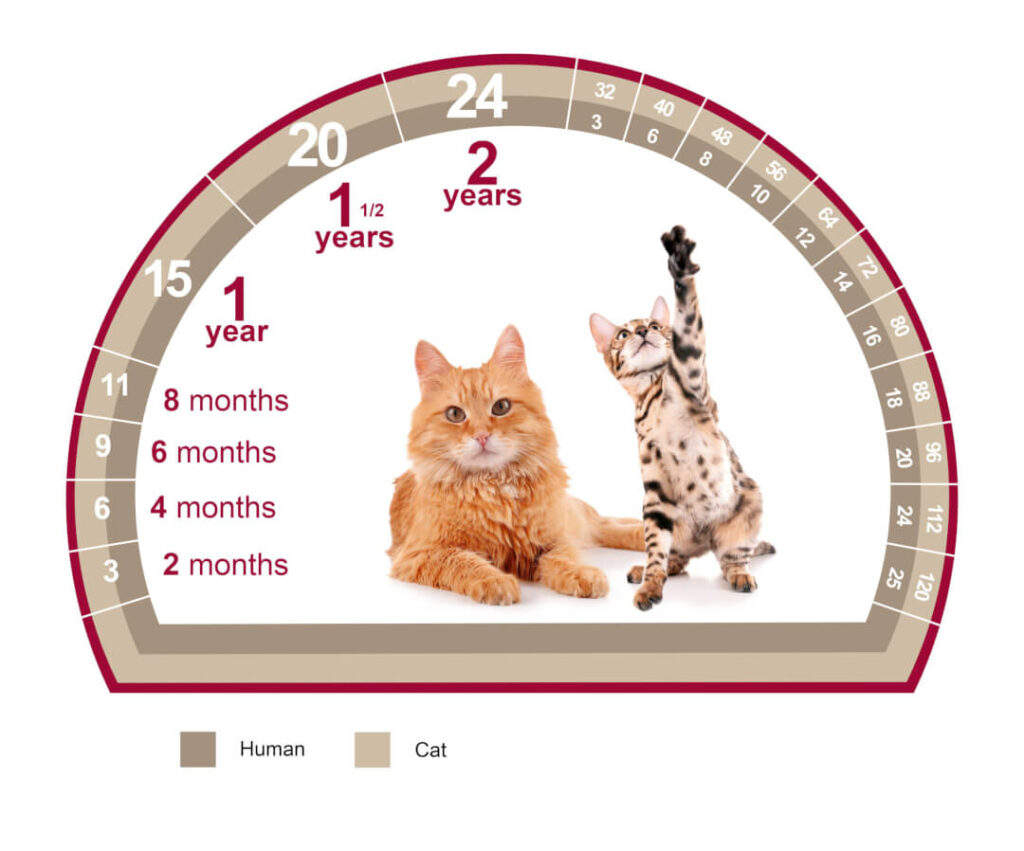
Quelle:www.haustier.net, Stand 23.10.2019
Life expectancy of cats
There’s a common belief that cats have more than one life. It’s a bold idea, probably linked to the fact that our feline friends are very smart and adaptable. Their razor-sharp instincts often save them, even in life-threatening situations.
However, many outdoor cats are victims of accidents: when they cross busy roads or come into contact with harmful substances. Cats that don’t freely come and go and live as purely indoor kitties have a better chance of growing old if they are protected from domestic hazards.
“Most accidents happen in the home” – is a saying that unfortunately also applies to indoor cats if the house is not fully “cat-proof”. Many cat owners believe that indoor cats are already well protected.
This can be true, especially as there is (usually) no prowling at night, environmental toxins or road traffic. But even a domestic household can be dangerous.
What you should know about a cat friendly home.
How do cats change with age?
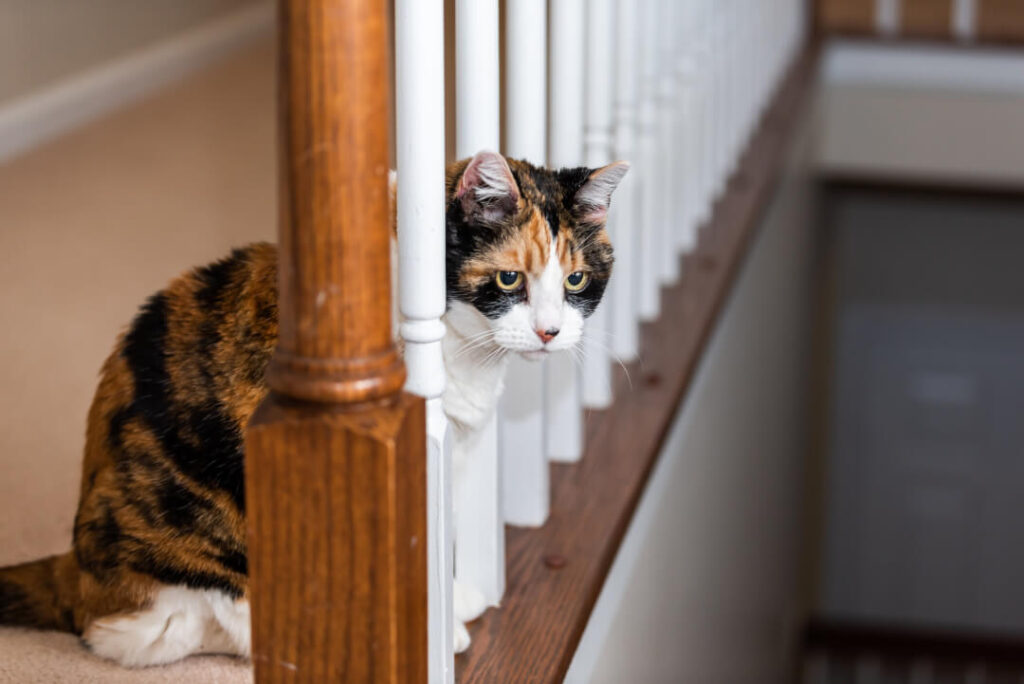
Every cat ages. Each one differently. Depending on genetic predisposition and external factors, the ageing process can be faster or slower.
And your cat will experience similar things to you in ageing: the body changes and things no longer come so easily. Life becomes more and more difficult.
Elderly people (and cats) are less active and some become overweight because they burn fewer calories. One of the reasons for this is that the metabolism changes and there is less muscle mass available. We used to climb three floors in a matter of seconds, but now we’re not so quick anymore. We get out of breath going up stairs; maybe our joints hurt with every step.
You automatically slow down a little…or you opt for the lift.
What’s the difference between an adult cat and an elderly cat?
From the age of 7 cats slowly but surely begin to age.
This is usually not that obvious, so you can’t really notice the change in your cat. It’s only when there’s a combination of signs that it becomes clear that your velvety-pawed puss is now an elderly dear. S/he doesn’t behave quite as you expect.
This may be because s/he is no longer aware of everything that is going on around: his or her senses are failing. This is unsettling for our furry friends.
They are no longer able to assess their surroundings properly, they can’s see or hear so well and become more cautious and affectionate.
Some seek more contact with their owners and become more cuddly.
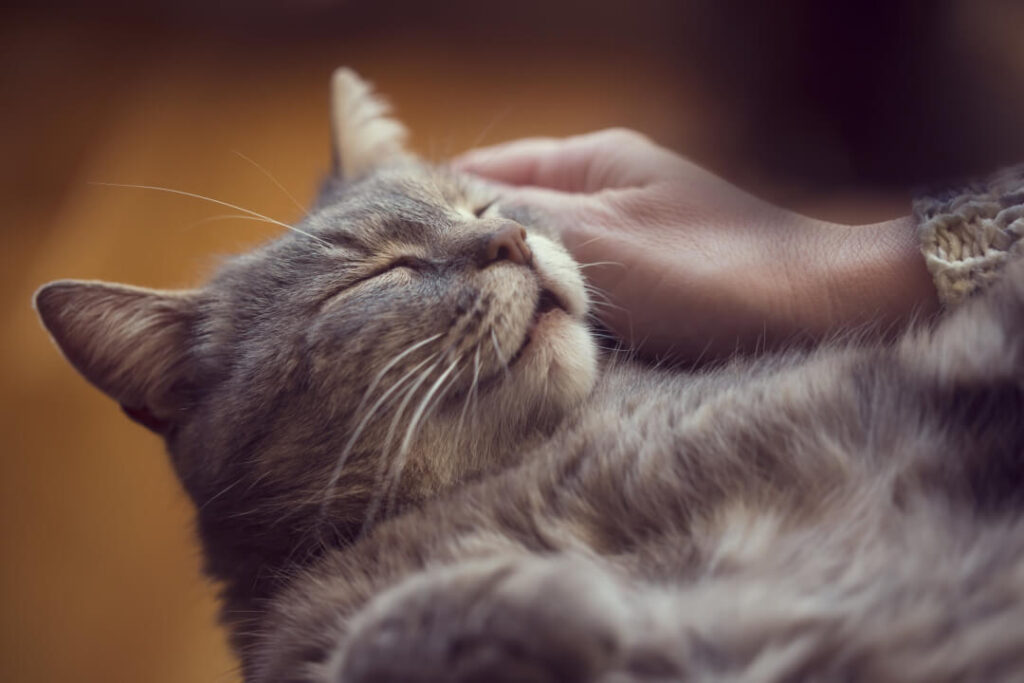
Cats generally become a bit quieter as they get older, preferring to retreat to a quiet place even more than usual, and sleeping more than they used to.
Even a nighttime rover who roamed over a large territory and never got enough of playing and romping around becomes a couch potato when he’s older, preferring to leave the field to the young tomcats.
What does an older cat need?
Elderly cats are different from kittens. And they have specific needs. A kitten has other requirements individually adapted to this phase of life compared to an adult or older cat.
An older cat is less agile and less energetic.
The hormone balance has also changed. Its coat becomes a little thinner and not quite as shiny as it used to be.
In order for your older cat to stay healthy and feel good, s/he needs different food.
Instead of power food with lots of calories to fuel increased energy requirements, s/he needs one that contains the vitamins and proteins for this stage of life.
What should I do about feeding?
In order for your older cat to stay healthy and feel good, s/he needs different food.
Instead of a power food with lots of calories to fuel increased energy requirements, s/he needs one that contains the vitamins and proteins for this stage of life
Some cats also develop food issues as they get older. They no longer have a big appetite, and only eat certain food.
Other cats have health problems affecting the jaw and mouth. Inflamed gums and dental problems can cause problems and restrict food intake. Even if teeth fall out, cats can still pick up and chew food, but it just gets a bit more tiring and takes longer.
Most cats continue to eat at their usual feeding bowls. But as they get older, some of our furry friends develop different eating preferences.
Tastes are fundamentally different. Is there even a perfect bowl for cats depending on whether they’re young or old?
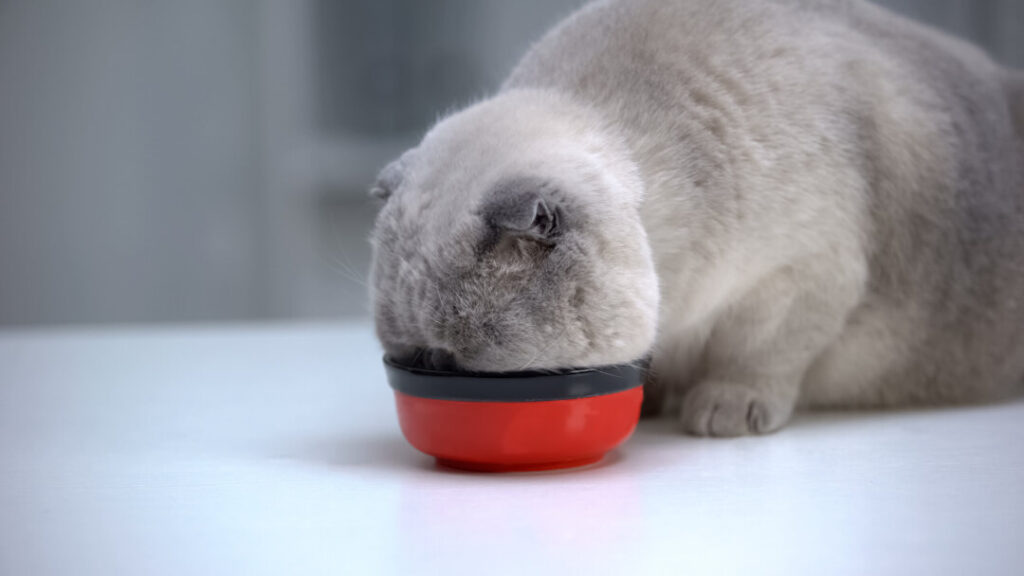
Well yes……the bowl here is probably a bit too small!
It‘s quite important to have a low edge, not higher than 4 cm, so that your puss can comfortably reach the food, but nothing can spill.
A round, flat bowl made of porcelain, ceramic or glass, with a minimum diameter of 15 cm is perfect. There is enough space to reach the food from all sides and you can easily clean the bowl and even put it in the dishwasher.
What should I give an older cat to eat?
What’s the best thing to fill an older cat’s bowl?
Special senior cat food contains vitamins, minerals and fibre that your feline friend needs at his or her advanced age. The food should be carefully prepared and adapted to your picky puss.
Make sure it’s high quality food and contains all the nutrients that an older cat needs, but without putting a strain on the body. An elderly cat’s kidneys and metabolism work differently and slower than before. So choose a food that’s easily digestible.
When younger, a cat often eats like a vacuum cleaner. As soon as the food is poured, s/he has practically hoovered it all up and the bowl is clean.
Now, at her advanced age, does it take almost all day for your kitty to get up and eat?
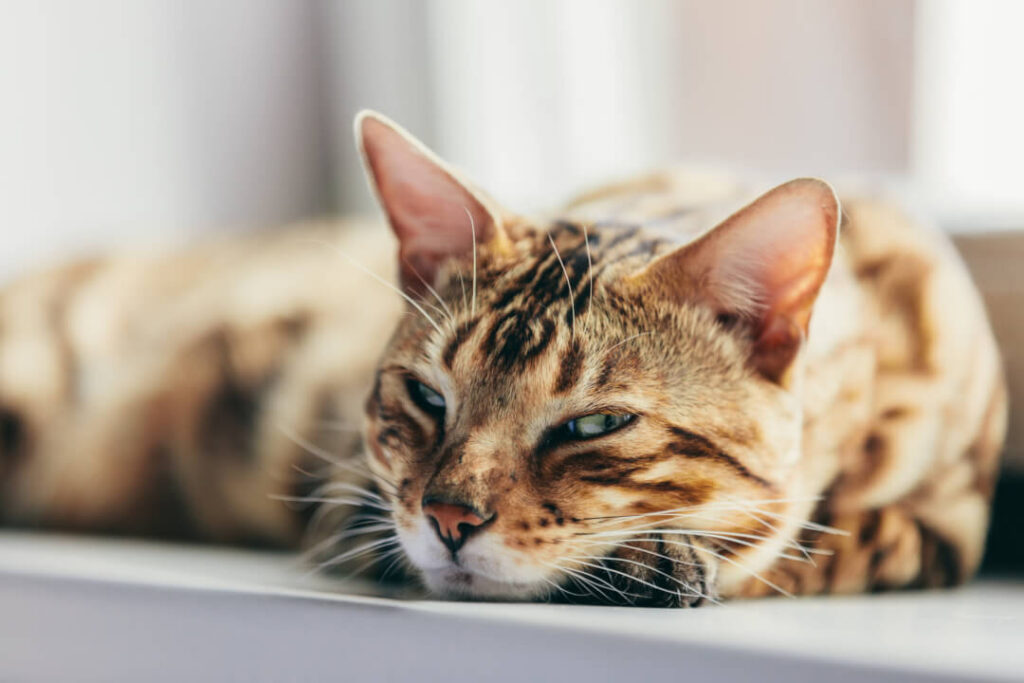
While some cats gain quite a bit of weight as they get older, others lose their appetite, or change taste and suddenly stop eating their lifelong favourite food.
Some cuddly companions go on “hunger strike” and spurn everything on offer. Cats can carry this on for quite a long time…
You worry: why doesn’t s/he eat? Is there anything you can do to make him or her like it again?
If your kitty is no longer very mobile, provide food in a raised bowl. Then it’s easier for him or her to eat, because s/he can do so standing up, at eye level.
Elderly cats often find dry food difficult to handle. When they’re old, offer high-quality wet food. Wet food not only smells and tastes more appetising; it also has the advantage of being easier to chew and contains more liquid.
TIP: If your cat needs to take medication as s/he gets older, you can easily add this to wet food. Simply crush the tablets with a spoon and mix the powder in.
This is easier for your cat and will make both of you less stressed.
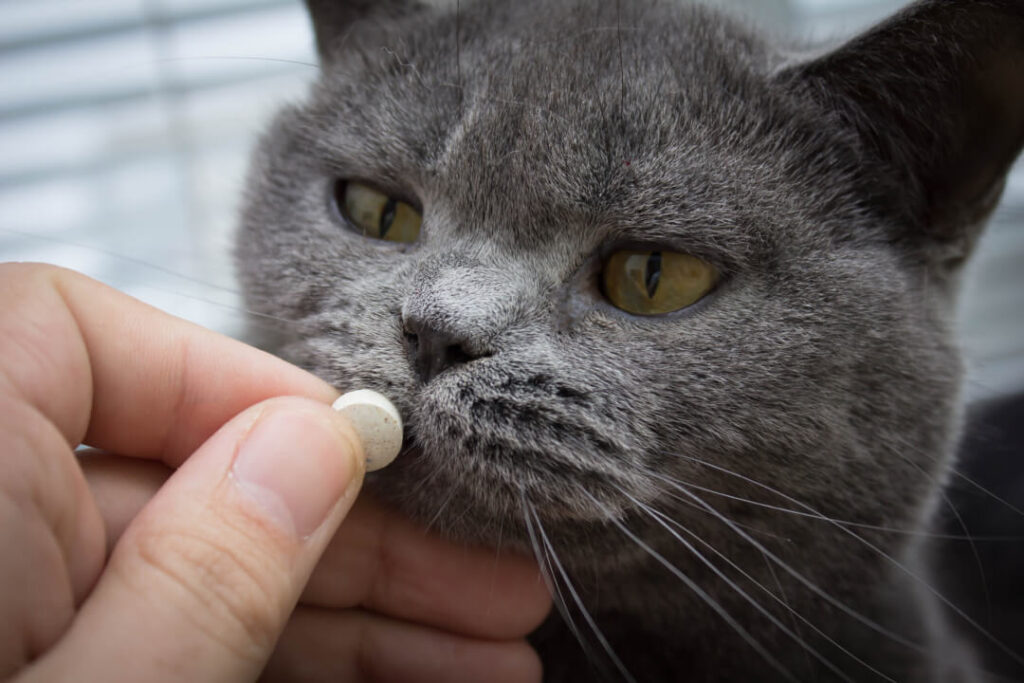
You can warm the food a little to make it smell more or enhance it with some flavours that your cat likes. A little chicken broth, malt paste, a slice of salami or some tuna often work wonders!
Malt paste is not only tasty, but can also help with digestion. It consists of vegetable oils and fats and has a positive effect on the stomach and intestines – even with hairballs.
If you’re not sure, ask a vet you trust. S/he knows your cat and will recommend a product that suits.
You shouldn’t overdo it with the extras either! Otherwise, your cat may only fish out the good bits and the rest will stay in the bowl.
If you give them new food that they don’t know yet, you can also offer a first taste on your hand. A cat that can’t smell that well will trust you and your hand and thus be more likely to accept the food.
How much food does an older cat need
Cats, no matter their age, can’t and shouldn’t be lumped together.
How often and how much you should feed a cat depends on how well they are, what they weigh and how active they are.
Bear in mind their physical condition and mobility, their calorie and energy requirements. You should judge their food on this at every stage of life.
Like elderly people, many cats often have problems with their joints and locomotor skills as they get older. Special food for older cats contains additives that support joints. Although this cannot prevent wear and tear, it can slow it down a little. The world is continually spinning: nobody can stop ageing and the ravages of time.
As cats get older, it’s better to eat several small portions and ensure they are easy to eat and digest. As kidney function deteriorates with age, you should choose a food that doesn’t put too much strain on your cat’s kidneys.
NOTE: An apple for us is like a mouse for cats.
Let your cat continue catching mice as long as s/he can. Hunting is good for them and in a biologically healthy mouse there’s everything a cat needs.
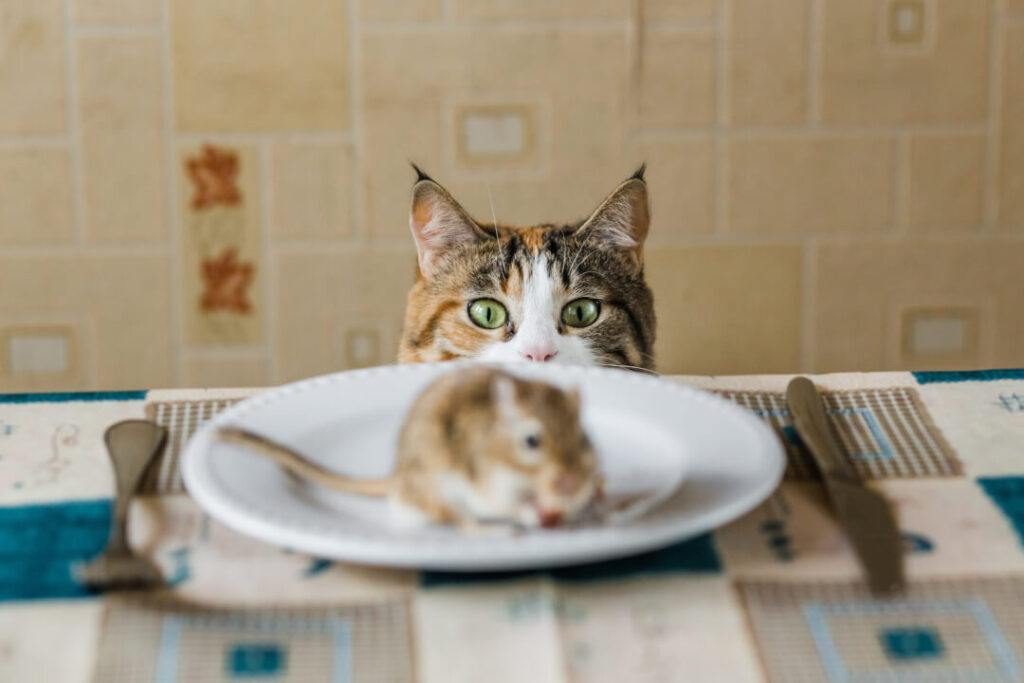
Which foods should be avoided?
Basically you should make sure that your cat’s diet is natural and balanced at all ages. This is especially important for older animals.
Avoid food containing artificial ingredients or additives, preservatives and products that have no place in a cat’s diet (“plant and animal by-products” such as vegetables, rice, cereals, fruit, soya, bone meal, fur, bones, feathers, beaks, wool, urine, blood, intestines).
Cats are carnivores so they don’t need carbohydrates that are better to avoid completely. Many dry and cold-pressed cat foods however use carbohydrates for shaping.
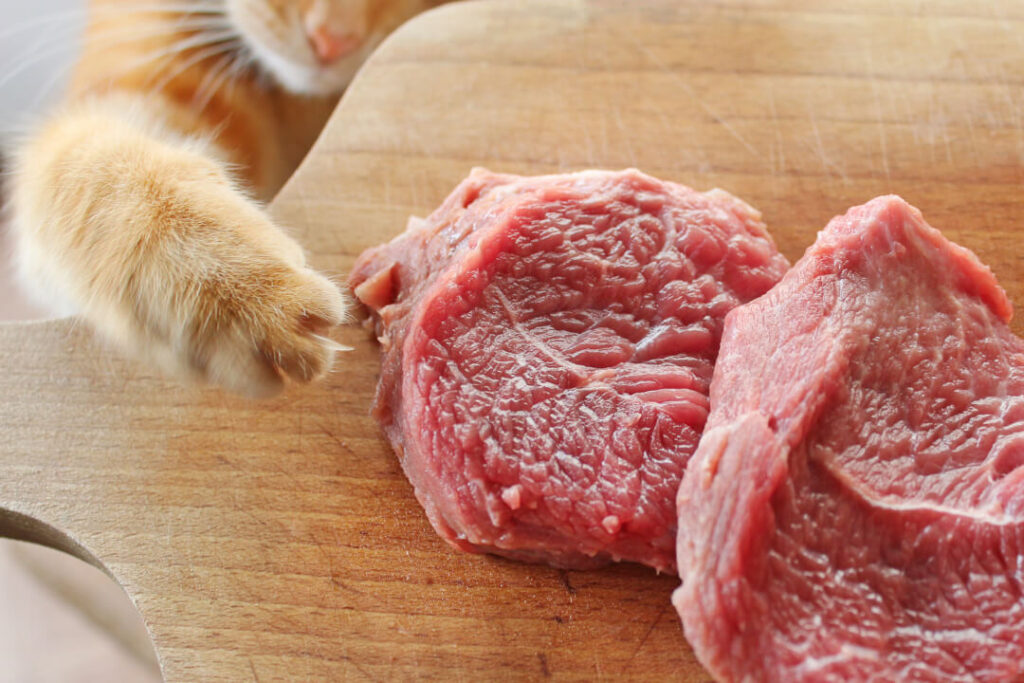
Choose a food with a lot of fresh meat, without grains and preservatives, and preferably with no or very little sugar. Most types of cat food contain sugar as a flavor enhancer. Industrially produced food is usually sweetened because that’s what feline consumers – our cats – enjoy.
NOTE: “If the feed is left open in the refrigerator or feeding place for too long, it can be spoiled by fungal infestation or parasites, such as fly larvae. These decompose the nutrients and form harmful toxins that can lead to cat illnesses”.
How do I care for an older cat?
Do you want to make it easier for your cherished cat to grow older?
Elderly cats are not so agile and sleep more during the day. Their senses deteriorate – they no longer hear and see as well. This is a bigger problem for cats, as they cannot use visual or hearing aids. As a result they stay close to what’s familiar, seeking proximity and comfort to give them a sense of security.
So just be there for your cat. Let him or her feel that you are close by and that there to support them.
Create resting spots where s/he can sleep in comfort, undisturbed.
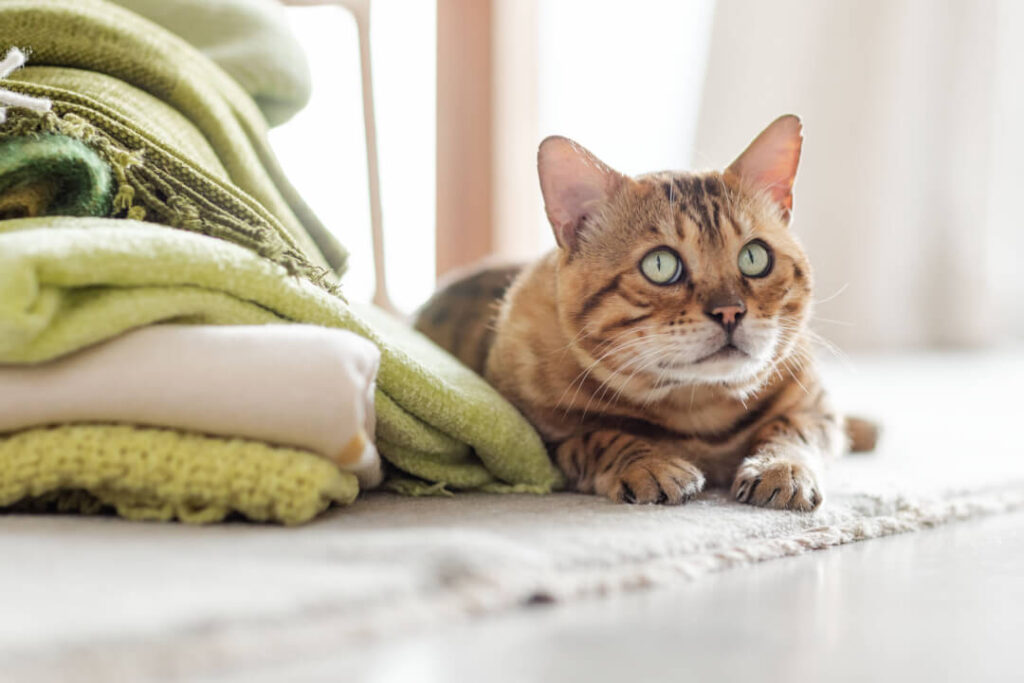
Maybe your cat can’t groom itself properly because s/he is less mobile and not able reach all the places that need attention. You can do that for him or her: brushing more often, cutting claws if necessary, cleaning eyes and ears regularly and checking teeth and gums every now and then.
Create one or two more low-level litter trays for the living room and also outdoors. As they get older, cats can no longer control their need to urinate as well, so a quiet toilet spot nearby is very welcome!
You can find all the inside tips about litter trays here:
Show affection or leave them alone?
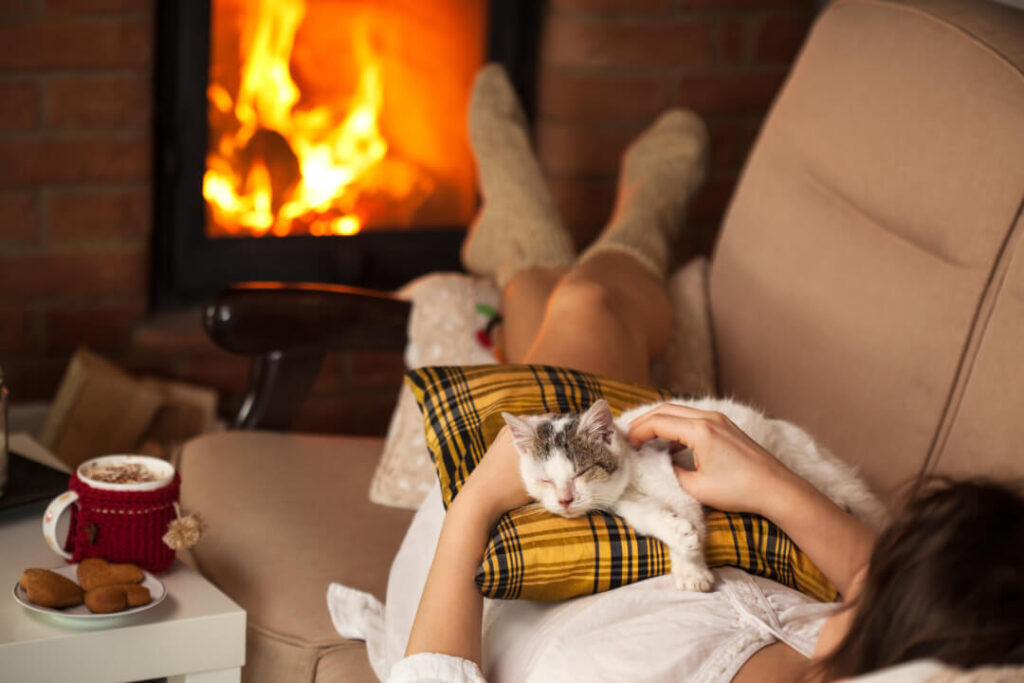
Your cat sleeps quite a lot now. Does it disturb him/her when you stroke or suggest playing?
Many cats need more rest as they get older, but they usually become more snuggly and affectionate. Cuddle your cat when s/he approaches you for this. And play with him/her: exercise is good. When s/he has had enough, s/he will automatically stop.
Time spent playing is probably not as long as when they were young, but they are good for your cat’s metabolism and muscles.
Show him/her that you are happy that s/he is there.
Talk to him/her gently.
Don’t shout: s/he isn’t deaf! Even though s/he may not be able to hear you properly, she understands exactly what you want to tell him/her. S/he knows you and precisely what you want to say and mean through facial expressions and body language.
Create climbing aids?
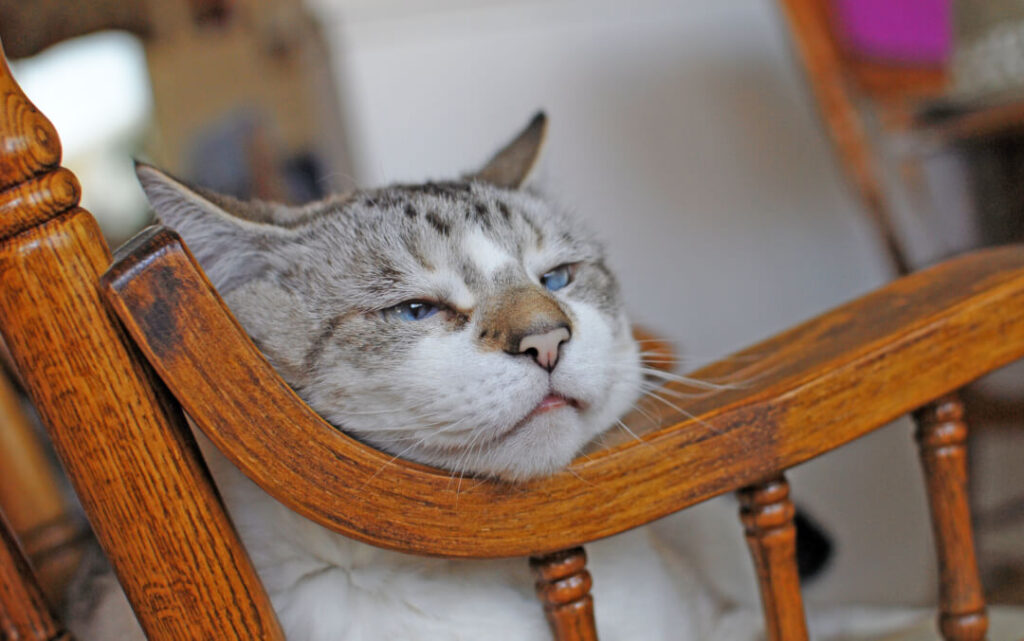
On top of the world – an exciting vantage point for cats is a raised lookout.
Unlimited freedom, a place up on high – that’s a cat’s kingdom. They can retreat there and still keep an eye on everything from a dignified distance.
But as cats get older, they are no longer as agile as they used to be, and can’t jump up and down so easily from their favourite places.
So make it easier for your cat: create transitions to make it simpler for them to reach those high spots. It doesn’t take much – a small stool, a ramp or stairs are often enough.
For older cats there are also age-appropriate scratching posts that are easy on the joints and can be reached without much effort.
Games and toys?
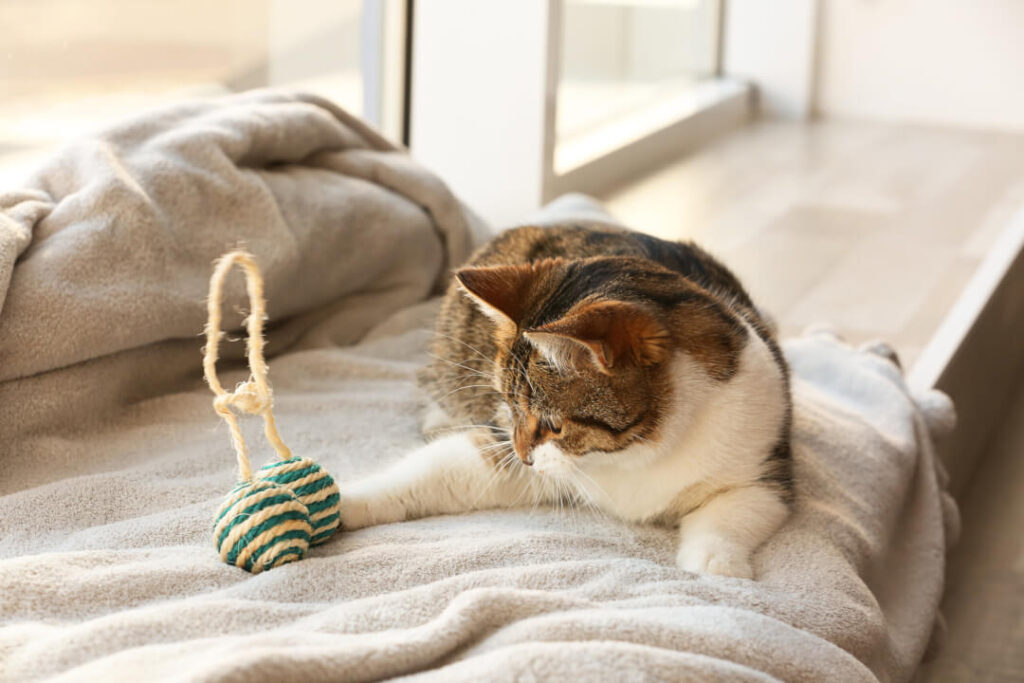
Even older cats like playing.
Maybe not as much as youngsters, but they still want fun and variety.
How can you make sure your cats have fun in your home? With a cat friendly home!
– Even in old age you/they can have fun!
Nobody should be bored, even in those twilight years. Otherwise, over time it can even make you ill. Older cats keep on playing and staying healthy and lively. Movement stimulates metabolism and digestion, keeping muscles in shape. These are important because they maintain the body: supporting your cat’s skeleton and joints.
Basically, older cats can enjoy the same toys as younger ones. Whatever they like and enjoy is allowed.
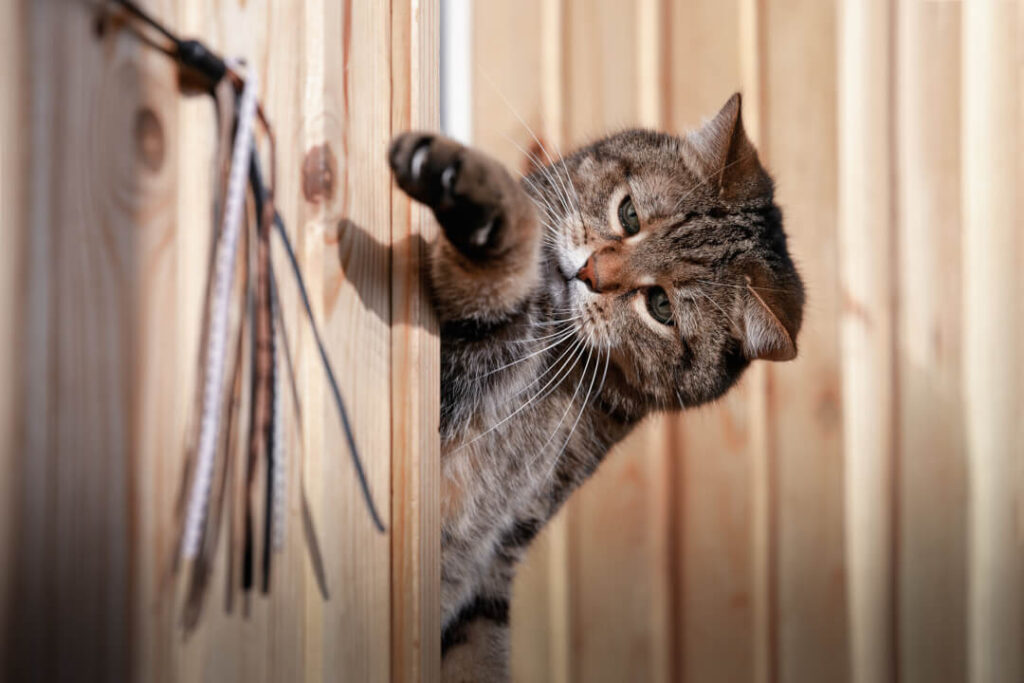
For older cats, choose toys that stimulate body and mind and are adapted to your pet. A cat with osteoarthritis will find it harder to chase a laser pointer; a cat with gum problems will not enjoy biting hard toys.
It’s better to choose toys that they won’t get easily bored with, and that keep them occupied longer.
What diseases do older cats get?
You don’t necessarily notice that your cat is getting older. With our furry friends, there aren’t grey hairs or other external signs. S/he may have become a bit calmer and sleeps more than usual. Maybe they retreat into themselves more and take things a bit slower.
Some cats are healthy up to a ripe old age. For other cats, diseases such as arthrosis, kidney and thyroid problems or diabetes (Diabetes Mellitus) occur with increasing age.
Dementia
You notice that your cat suddenly behaves differently than usual.
S/he doesn’t react normally, doesn’t want to cuddle, seems somehow disoriented, helpless, doesn’t seem to know the way around?
S/he doesn’t really land where s/he should when jumping and has sleeping problems?
S/he may mew louder and more insistently than usual, as if shouting “SOS”, “What’s wrong with me?”, “Help!” If this happens more frequently, your cat might have dementia. At first, symptoms only appear now and then, then increasingly more often.
The earlier you bring your cat to a vet, the better. Unfortunately, s/he cannot cure this, but can prevent the disease from progressing faster and make life easier for your furry friend with the right medication.
Outdoor cats with dementia have the problem of struggling to find their way home. In Germany you can register your cat for free with “FINDEFIX”. Someone who finds a cat can then use its registration details to find out whether it’s missing and submit a report.
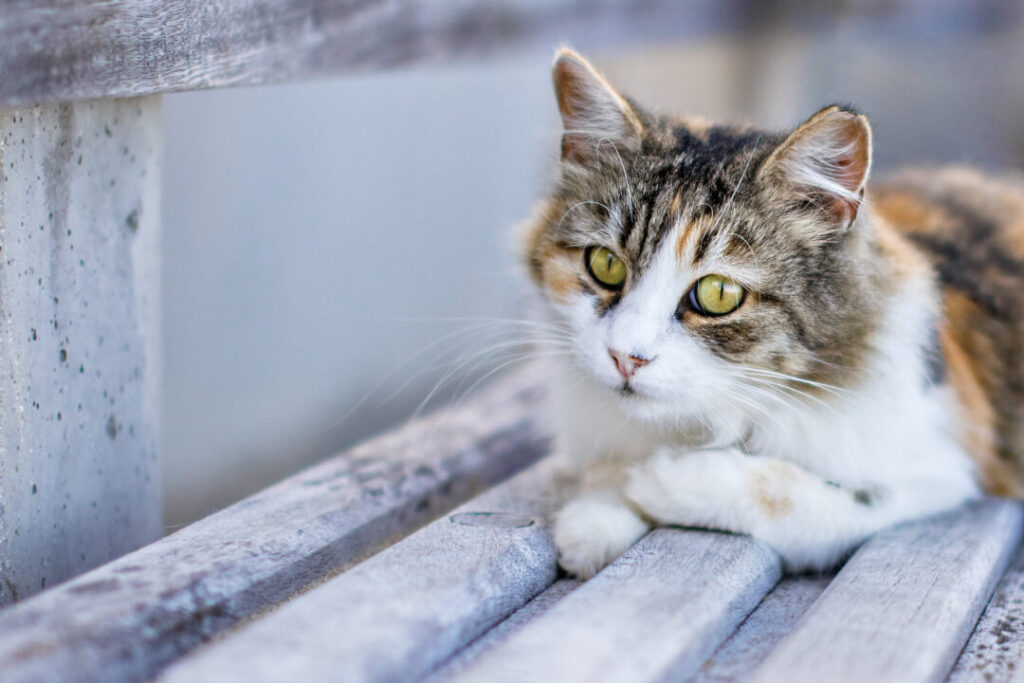
Cancer
Unfortunately, cancer does not spare cats either.
Like most four-legged friends, cats can hide diseases for a long time. Usually you realise relatively late something that hasn’t been spotted before. Keep an eye on your cat more closely as s/he grows older.
If s/he is breathing harder than usual, loses a lot of weight and has strange swellings on the body, this doesn’t necessarily mean cancer. Swellings can also be a tumour that is benign at an advanced age.
If you want to be on the safe side, have a vet check it out. The sooner a tumour is diagnosed the better the chance of helping your cat.
What forms of treatment are available for cats? An online guide will never replace a visit to the vet. Here’s a detailed list ofveterinary clinics and vets near you.
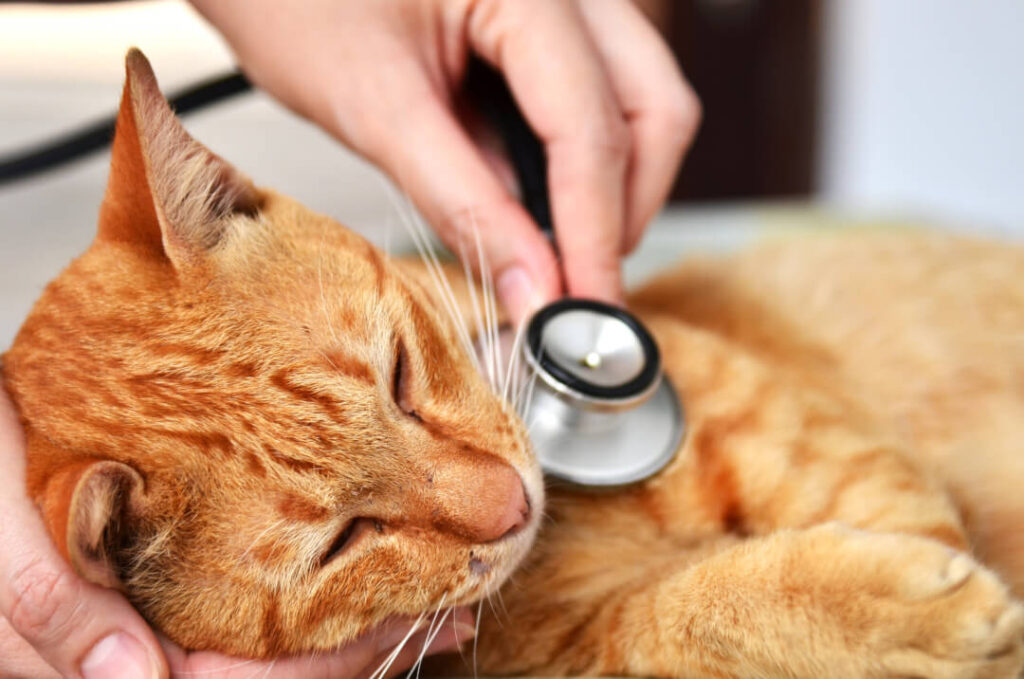
Incontinence
If a cat can no longer control his or her bladder as well as before and occasionally leaves small amounts of urine or faeces, it’s uncomfortable for both of you. Finding another puddle or pile, possibly on a carpet that’s not so easy to wash or clean, is not so pleasant.
And not for your cat either.
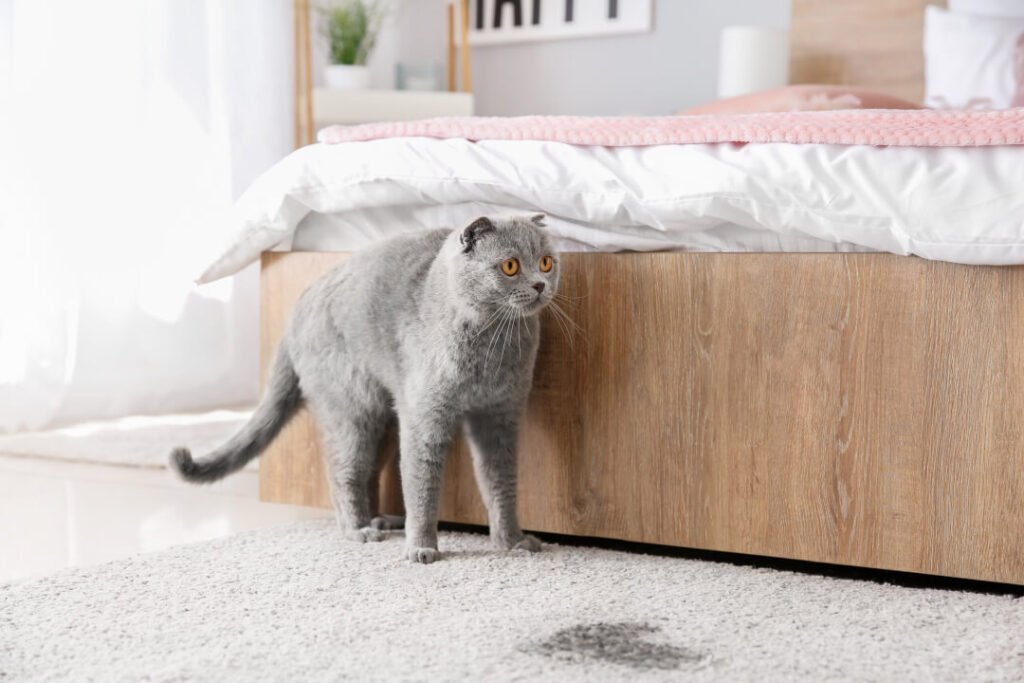
What causes incontinence? A weak bladder in old age? Or a urinary tract disease or bladder inflammation? These also cause a cat acute pain. To find out, you should have your cat checked out by a vet.
Get rid of pee puddles with enzyme cleaner and clean your cat’s genitalia with lukewarm water, a flannel and a gentle cat shampoo. Place more litter trays in strategic places, or put toilet training mats where accidents happen. Above all:
Don’t scold the poor puss.
It’s not your cat’s fault.
Renal failure
Pee puddles – bigger and more frequent than usual? In older cats, the kidneys often don’t work as well as they should.
Kidneys can withstand a lot, and you usually only find out that they’re damaged when there’s around 20% of them still doing their job.
Your cat will have been suffering for a long time and you will usually not notice many of the symptoms beforehand. That’s because there are no specific signs to indicate it.
A blood test and urine analysis at the veterinarian will reveal all.
Special food and medication can then help. Make sure that the cat drinks a lot so that the kidneys are well flushed. A drinking fountain often helps and is enjoyed by indoor cats.
Give wet food, so that your pet absorbs liquid from the food. For cats with kidney problems, specialist retailers offer specific dietary foods that contain less protein and so produce less urea.
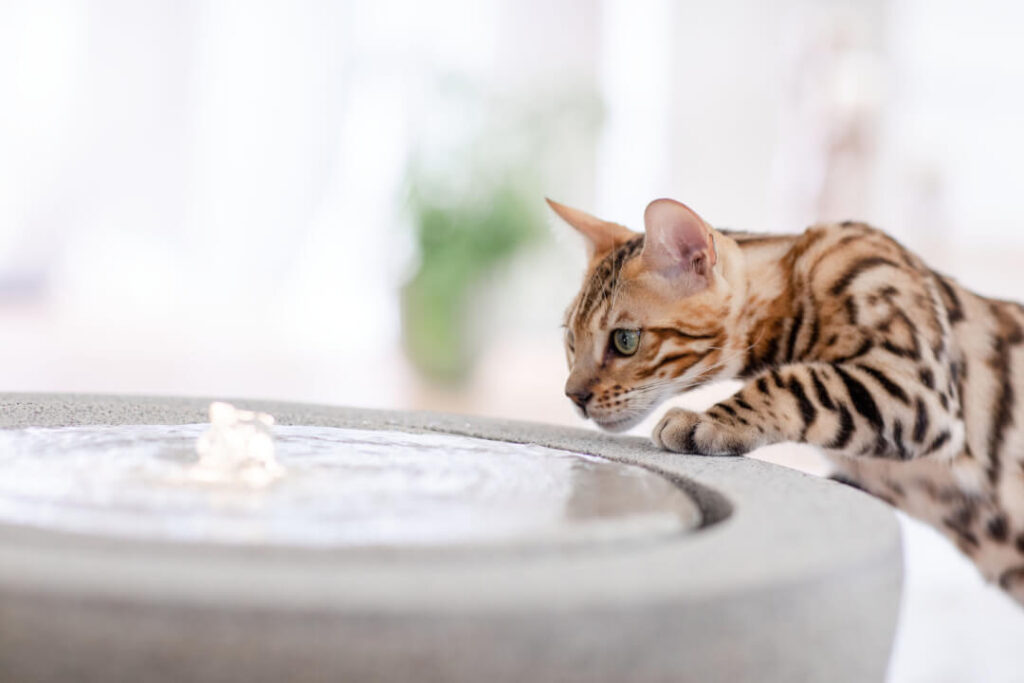
Diabetes
Older pets also often suffer from diabetes mellitus, a pathological disorder of sugar metabolism that permanently increases blood sugar levels.
When cats suffer from diabetes, they cannot convert glucose into energy because of a lack of insulin. Glucose accumulates in the blood, but doesn’t go where it’s supposed to – into cells.
Over time, this damages a cat’s nerves, organs and blood vessels.
Your cat will feel weak and instinctively try to make up for the lack of energy with more food, but won’t be able to use the energy properly. This will result in him or her eating more than usual and still losing weight.

Cats with high blood sugar need a special diet and regular feeding with certain-sized portions.
Talk to your vet. S/he will draw up a diet plan tailored to your cat.
Poor vision and hearing
You call your cat but nothing happens? She used to be quick, reacting to the slightest noise. He no longer looks at you the minute you come home? Is she sometimes unsure where to go?
Does he ignore you? No. It’s not that.
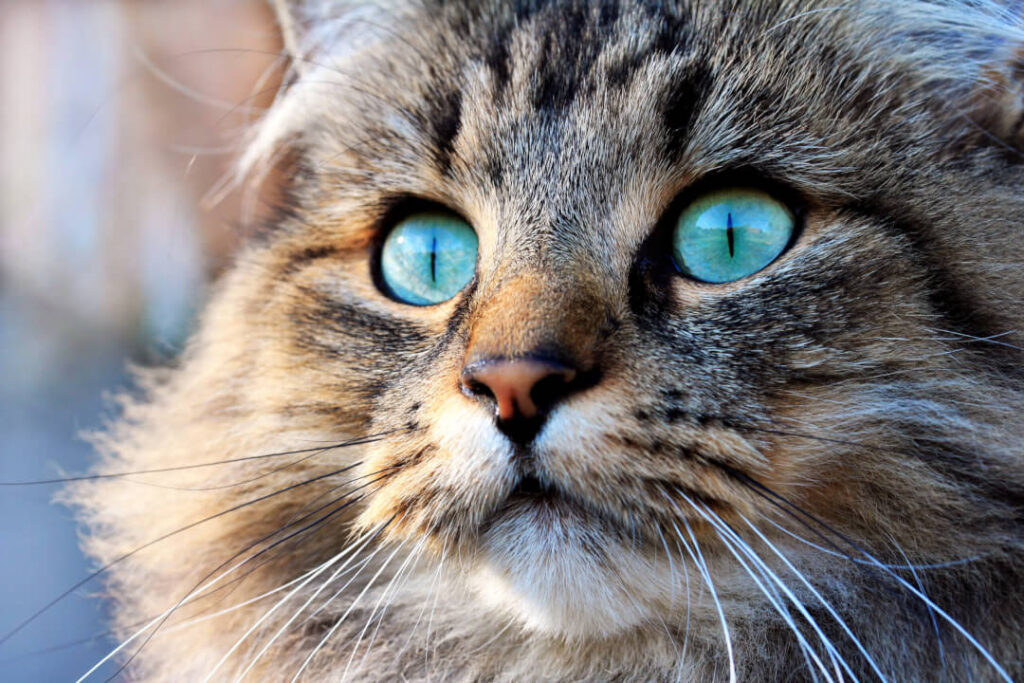
They just can’t see and hear you as well as they used to.
Their senses, which were extremely sharp before, have simply declined with age.
The older a cat gets, the more this happens.
But since a cat has seven senses, it can usually compensate for any deficiency relatively well over a long period of time.
And you can support him or her by spotting this earlier. Walk towards your cat slowly so that s/he is not afraid if you are suddenly standing beside. Show that you are happy that s/he is there. Talk to him/her calmly and gently stroke your cat when s/he notices you. This will give a feeling of security.
How old cats behave
Forever young? There’s no such thing. Not for people, nor for your cat. Ageing is part of life; it’s inevitable. The body changes: less muscle and more fat. And organs no longer work as well they did earlier in life.
Perception diminishes over the years. Seeing, hearing, smelling, tasting, feeling all don’t function quite as they did when you were young. A young tomcat is much more energetic and reactive than a cat-equivalent octogenerian
Some cats grow older faster and more intensely. Others hardly notice that they are getting older, and stay sprightly and cheerful until their final days!
Sleeps a lot
Elderly cats are not that active any more, and have less of an urge to move.
Instead, they sleep more, and longer than kittens.
Cats love resting places where they can take a nap undisturbed. As they grow older, they make even more use of their retreats.
Especially when they’re slightly elevated, cosy and warm.
Make your older cat really comfortable!
Make sure that your cat can get everywhere easily and not injure him or herself when climbing up or down
Grooming
The older we get, the more care our body needs.
This also applies to our furry friends. But it’s not so easy when they are less mobile.
Places that your cat used to be able to groom without any problems because s/he could easily get anywhere, s/he can no longer reach now. The joints hurt, balance is shaky from time to time…. that’s when it becomes a real challenge!
Tongue and paw care are important as they removes burrs, loose hair and parasites. If your cat can no longer do this alone, you can help him/her look after their coat. Stroke your cat extensively. It’s not only good for your relationship but also for blood circulation.
When stroking, you’ll immediately feel if there is something in the coat that doesn’t belong. If this can’t be removed by hand (e.g. burdock burrs), use a brush, comb or tick tweezers – but always be careful! Your cat will then look forward to it next time, because it’s an enjoyable memory.
From head to paw – you can find everything worth knowing about cat care here.
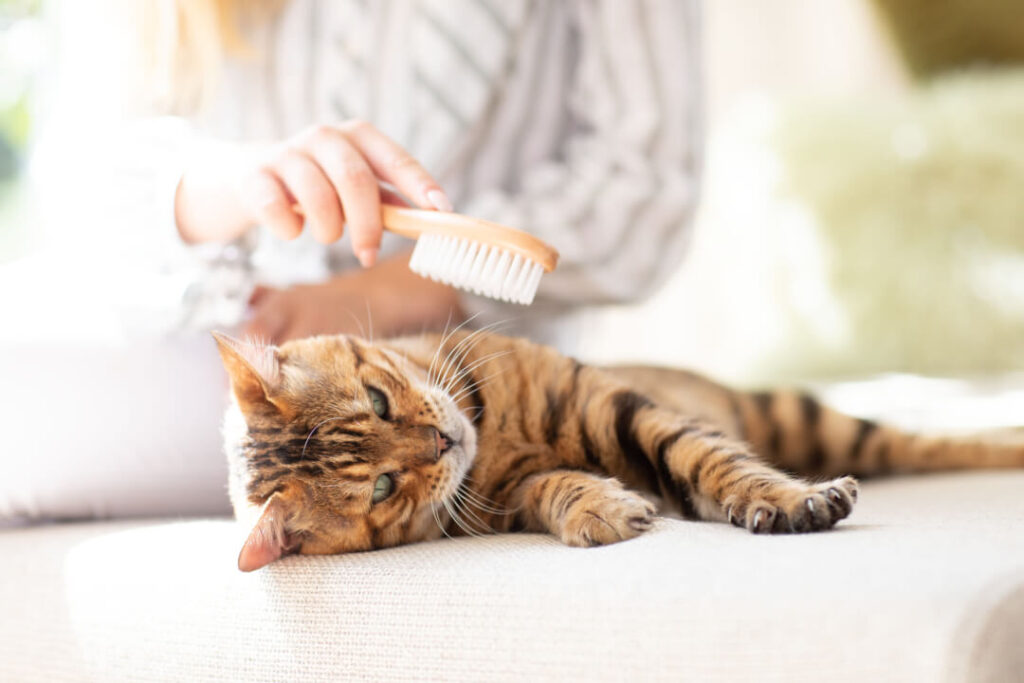
Less mobile
When kittens play they can go mad!
They show incredible stamina. The most popular games are always based on natural behaviour. A hunter likes sneaking up, lurking unseen and pouncing fast, so zig-zagging movements are just right. The unfortunate prey is caught when the cat pounces, jumping from a great height.
Older cats also play, but not to the same extent as kittens. Exercise is important, especially in old age, as it has a positive effect on the whole body. Your cat will stay fit and healthy for longer in old age if s/he stays active and mobile. But s/he mustn’t overdo it.
S/he will certainly have favourite games. If they’re not too “wild”, these can also be enjoyed in old age. Alternatively, you can try playing in a way that stimulates their brains: thinking games that continually challenge the intelligence of your furry friend.
More cuddling
Older cats are real cuddle pusses!
– Cats often become even more affectionate in old age!
Be happy and stroke him or her more than usual.
You’ll make your honey happy when you show you’re pleased to see him or her. Just like us, cats need affection and want to be cuddled.
Being close, being touched and body contact have a double benefit:
A tender touch soothes the mind but also helps cats feel physically better: stroking stimulates blood circulation.
Cuddling is not only fun, it also keeps you and your cat healthy!
Just do it more often.
Loss of appetite
Some older cats simply don’t have much of an appetite, so they may pass by their bowl several times a day and not eat.
You can either try with another type of food or open several small tins. If the food is kept at room temperature all day long, it will not be fresh in the evening and may smell less appealing. It’s better to replace it with fresh food. If you have to throw away just one tiny tin, it’s only a small financial loss. But it’s better than losing a maxi-portion.
Provide small portions throughout the day to an older cat. It’s also easier for your cat to digest.
You can also offer the bowl directly – showing the food first to see whether it’s the food or another reason. If s/he still doesn’t want to eat after a few tries, propose an alternative. So s/he makes the ultimate decision on which kind to eat.
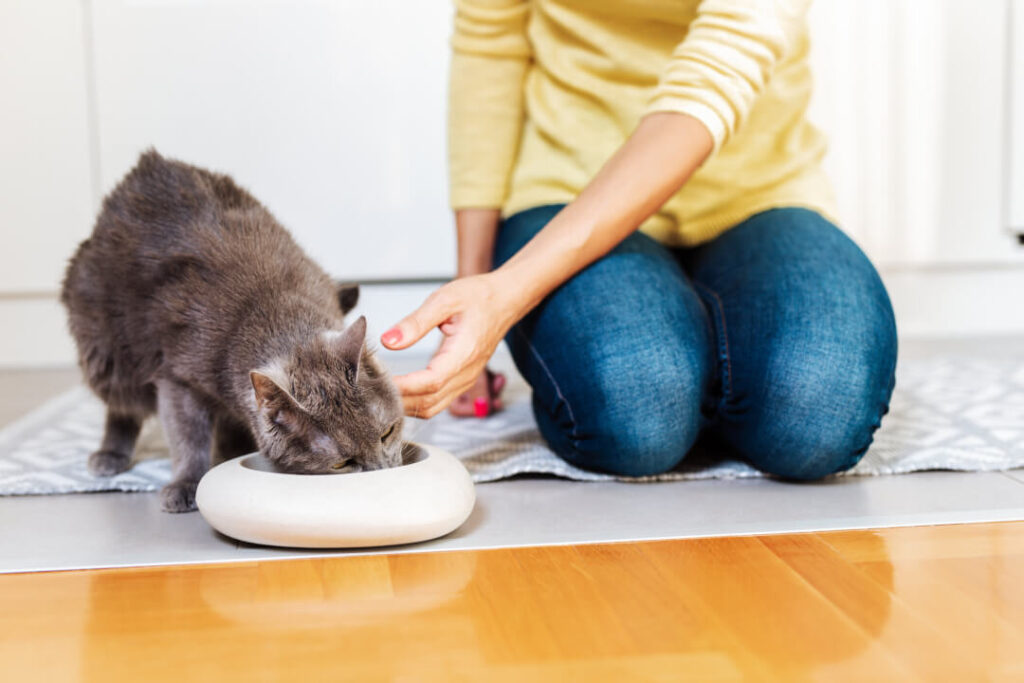
Becoming more stubborn
Cats at an advanced age can sometimes be quite stubborn (like us!).
Their attitudes towards things change. In old age cats are less flexible and no longer give in or put up with anything. No more compromise! They can clearly show their displeasure. Sometimes even react aggressively.
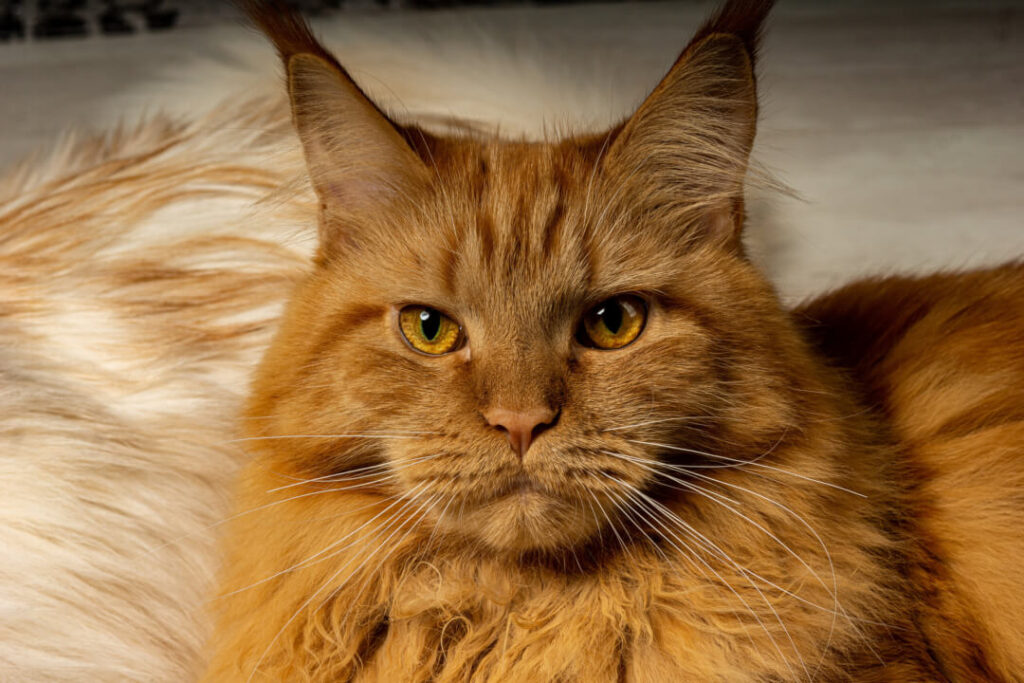
What’s the best way to deal with such a stubborn little lapcat?
Is there even a remedy for it?
No.
Not really.
But it helps if you understand why s/he’s sometimes like this. Your cat may not always react the way you want him or her to, but they certainly don’t mean any harm; on the contrary!
Most of the time, s/he just doesn’t understand what’s going on around, and feels insecure and disturbed. Try to treat him/her normally; don’t isolate them. Involve them lovingly in your life and show that everything is just as usual.
Physical changes
You can tell that the ravages time are affecting your cat by the way that s/he is changing physically. This can be very different from cat to cat.
While one may get thinner, another might be getting fatter.
This is because cats move differently in old age, and not as much as they did when they were young. Muscles that your furry friend used to need are worn out because they are no longer called on, and new ones aren’t being built up.
As with people, less exercise leads to a slower metabolism. And a slower metabolism results in greater fat reserves. If you sleep a lot and take it easy, you’ll get fat in the long run. If you hardly move at all, at some point you’ll no longer be flexible enough to move, because your muscles are in form. Then you’ll be on your knees.
Your cat will feel this too. S/he senses that it’s not as easy as it used to be. This makes many feel insecure. They become more cautious, no longer daring to do many things and withdrawing more and more.
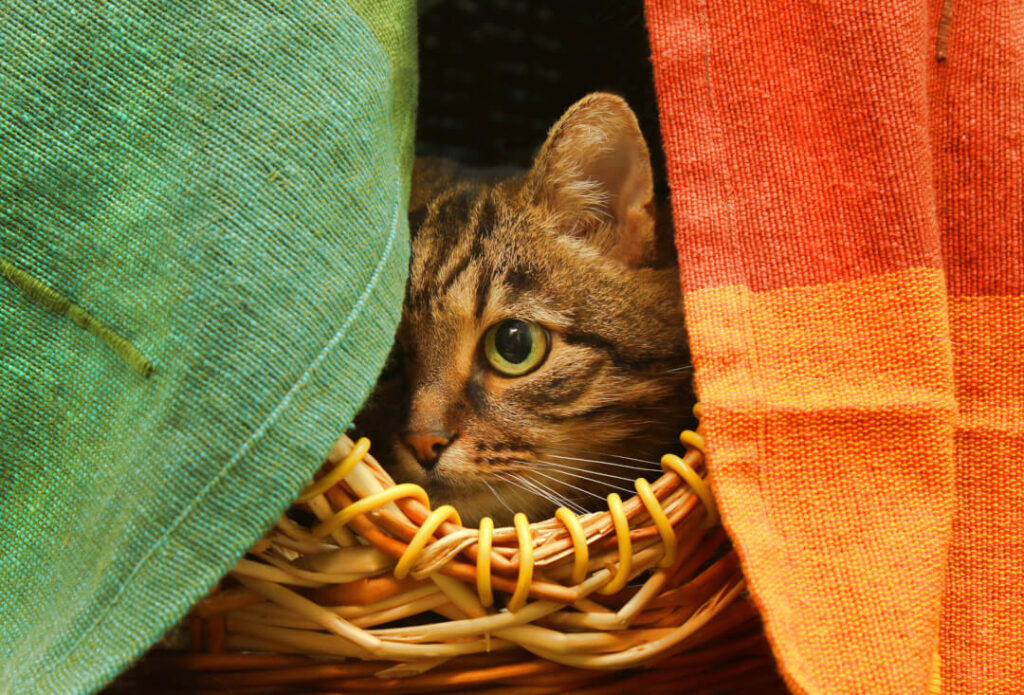
Signs and early detection of diseases
Pay even more attention to older cats.
Wenn Du feststellst, dass etwas nicht stimmt und Deiner Katze etwas immer mehr zu schaffen macht, If you find something wrong that’s causing your cat increasing discomfort, you’d better have it checked at the vet.
This does not mean that the slightest illness should ring warning bells and get you spending more time in the vet’s waiting room than at home. A visit to the vet is very stressful, especially for older cats. But if something seems serious, don’t hang around. If s/he is not sick – even better! You’ll be reassured to know for sure.
Even if s/he is ill, many diseases can be cured or relieved if they are detected and treated early enough.
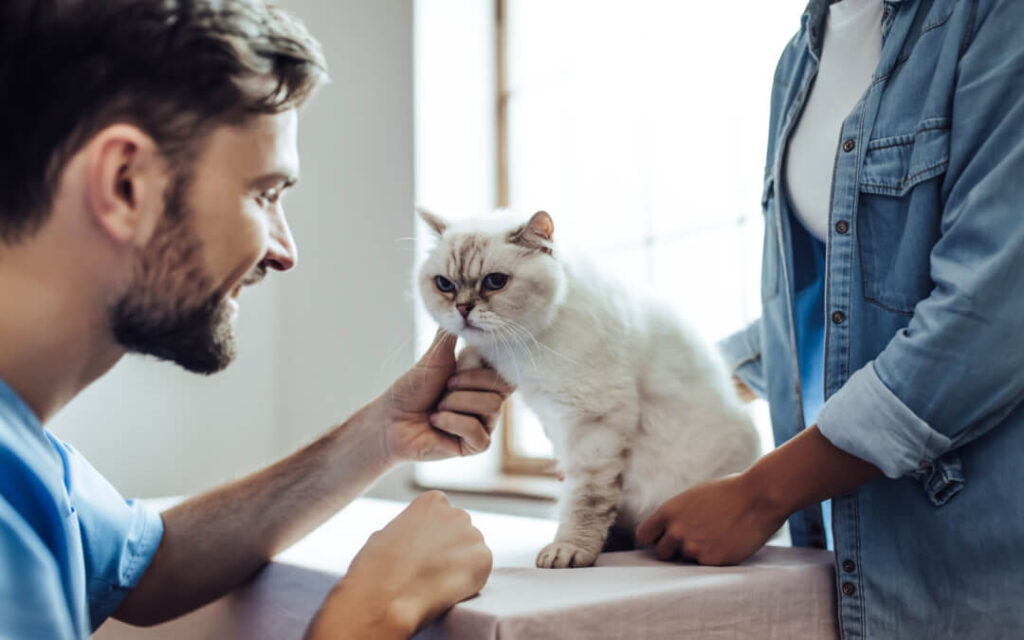
Older cats tend to get sick due to their age more than younger ones. So if you’re worried about higher medical costs, you may want to consider taking out a separate cat health insurance as they get older.
When a cat dies
No one lives forever. Dying is part of life, just like being born. Cats are said to have seven lives, but at some point even these are used up. Sadly that won’t change.
Cats understand their inner clock. They know instinctively when it’s time to go. They usually start physically retreating into themselves. They withdraw more and more, eat irregularly or not at all, and spend most of the day sleeping.
Even if it’s very hard for you, try to accompany them along this final path with dignity. S/he will have been your friend for many years, and was always there for you. Now they need you. So don’t leave them alone. Keep them company on their way. That’s best done in familiar surroundings. If possible, be calm and relaxed, without showing you’re sad.
When a cat is in too much suffering
Saying goodbye is already difficult. But choosing that moment is the hardest decision of all for animal lovers.
Everyone who loves their cat would prefer that they go to sleep gently and peacefully when the time comes, without any action on their part. Unfortunately, this very rarely happens.
If your cat is in great pain and it’s getting worse, you shouldn’t prolong the suffering and relieve him or from their pain. This is the ultimate act of love you can do for your pet. It may not be allowed for humans, but it is for pets.
Putting a cat to sleep
Your cat can then stay in a familiar environment and you save them and yourself the stress, fear and additional pain of going to the surgery.
The vet will first give your cat a sedative, then a high dosage anaesthetic. Your cat will fall asleep gently and painlessly with this. Stroke them, take them in your arms and show that there’s nothing for your cat to be afraid of. S/he is not alone – you’ve been with him or her to the end.
Saying goodbye to a much-loved cat
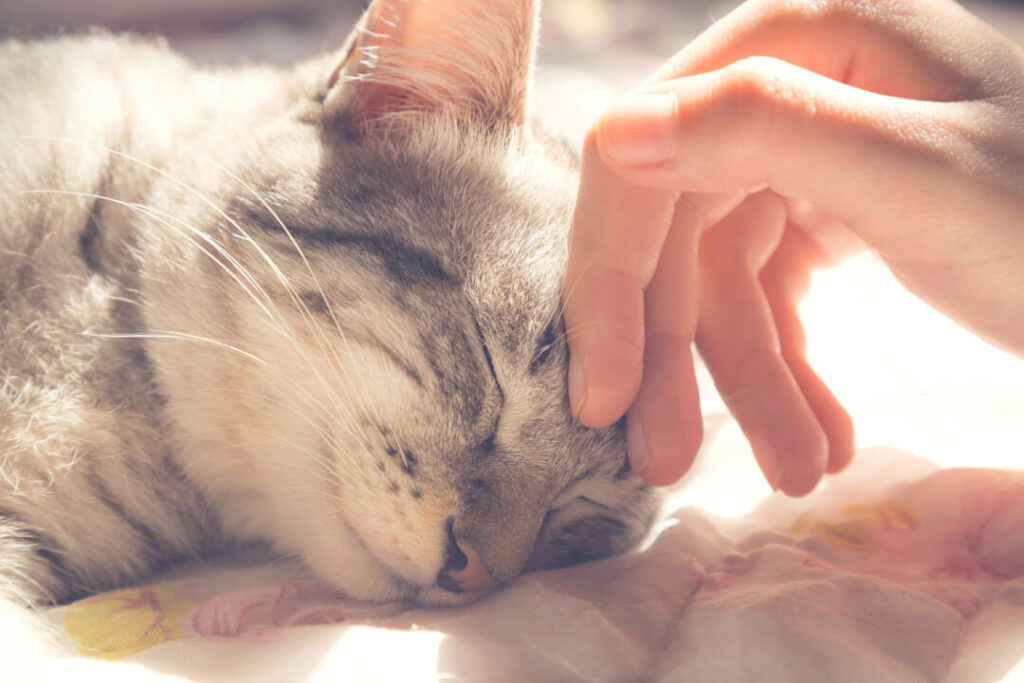
At first there’s a great emptiness.
There is no longer someone who muzzles, weaves around, greets you and comes up for a cuddle. And there are still traces of them everywhere: cat baskets, bowls, scratching posts or favourite places that your furry friend liked to visit, where s/he has left fur or scent. The time that follows is hard.
You’re constantly reminded that something or someone is missing.
Your heart aches. Tears and grief: you feel like they will never stop. But at some point it gets easier. Time doesn‘t heal the wounds, but it becomes more bearable. Everyone grieves differently. So all of us also deal with saying goodbye and mourning in our own way.
Take the time to say goodbye and remember your cat whenever you need to.
Where can I bury my cat?
One last difficult decision you have to make:
After saying goodbye to your cuddly companion, what happens to his or her body now?
There are different regulations for this depending on the country where you live in.
If your cat was ill and you had to put him/her to sleep, your vet will probably suggest that you leave the body at the clinic. Pets are then incinerated in a crematorium.
You can also take the body there yourself. However, there are strict hygiene rules you must observe. The disposal fee depends on the weight and size of the animal. If you have your pet collected, this costs extra.
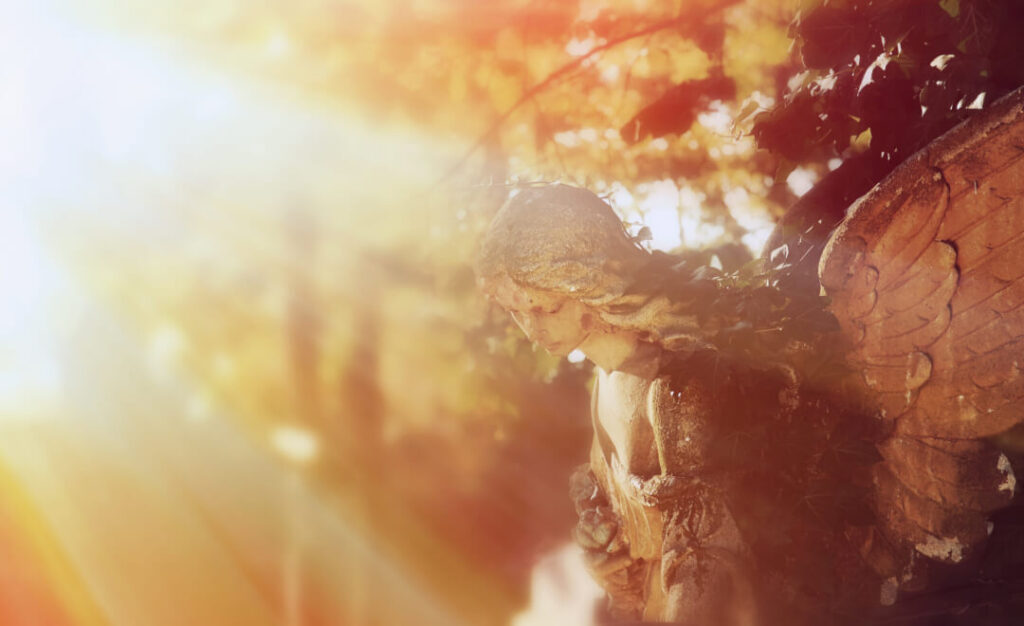
Many cat lovers choose a different route. Their pet has been a faithful companion for years and they want to keep it close.
If that’s not possible, then at least a permanent resting place.
Pet cemetery
If you don’t want to leave your velvety-earred friend to be disposed of and you don’t have your own garden, you can also choose a cemetery for an appropriate burial. Here your cat can be buried in a grave with a coffin or urn.
However, this is relatively expensive. The cost of the grave site, coffin, urn and possibly grave maintenance are naturally higher than crematorium fees.
If it’s important for you to always have somewhere permanent to visit and remember your pet, then this is a sensible alternative.

Buried in the garden
If you have a private plot of land, you can bury your pet in your own garden, as long as it’s not in a water or nature reserve and your cat hasn’t died of a disease that needs to be reported. You should, however, observe the relevant local regulations:
You must bury your cat at least 50 cm deep.
First wrap the body in biodegradable material, for example recyclable fabric or paper.
If your cat has died of a disease that could be transmitted to humans, cremation is better.
TIP: Please don’t bury a dead cat in public gardens, parks or woods! Large fines will be imposed.
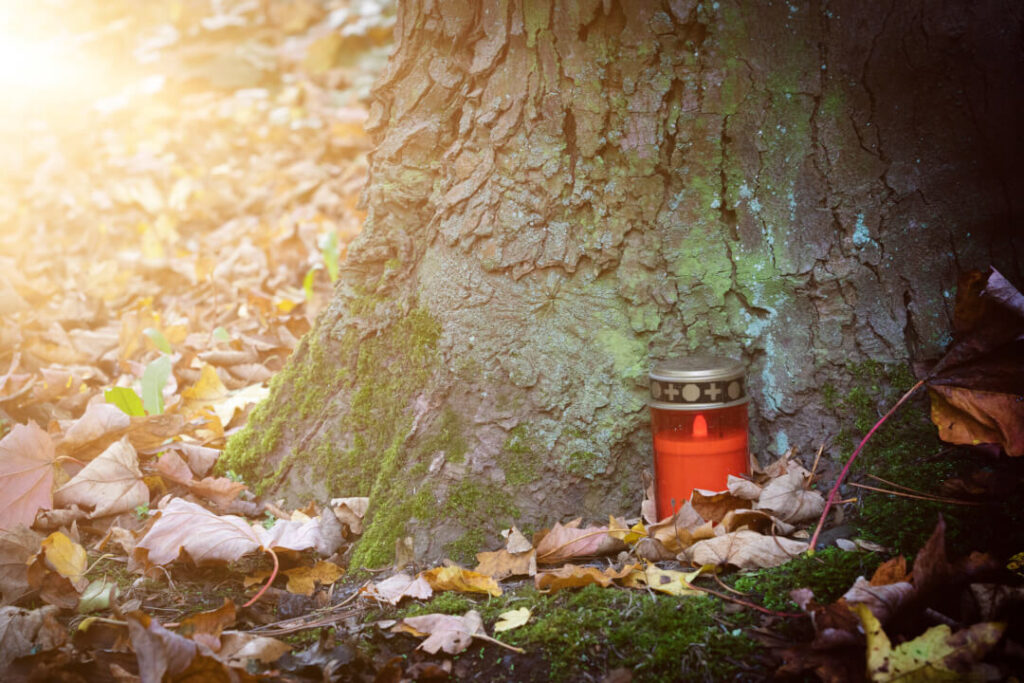
Crematorium
You can also cremate animals, like we do with friends or family when they’ve passed.
Many cat owners would like to keep their pet with them after death or bury him/her nearby.
For example in Germany, at certain cemeteries you can be buried together with your cat. There it’s possible to bury an urn with human ashes and another with the ashes of your cat together in one grave.
In the city-state of Hamburg, it will soon be possible to add an urn of pet ashes to a grave on request.
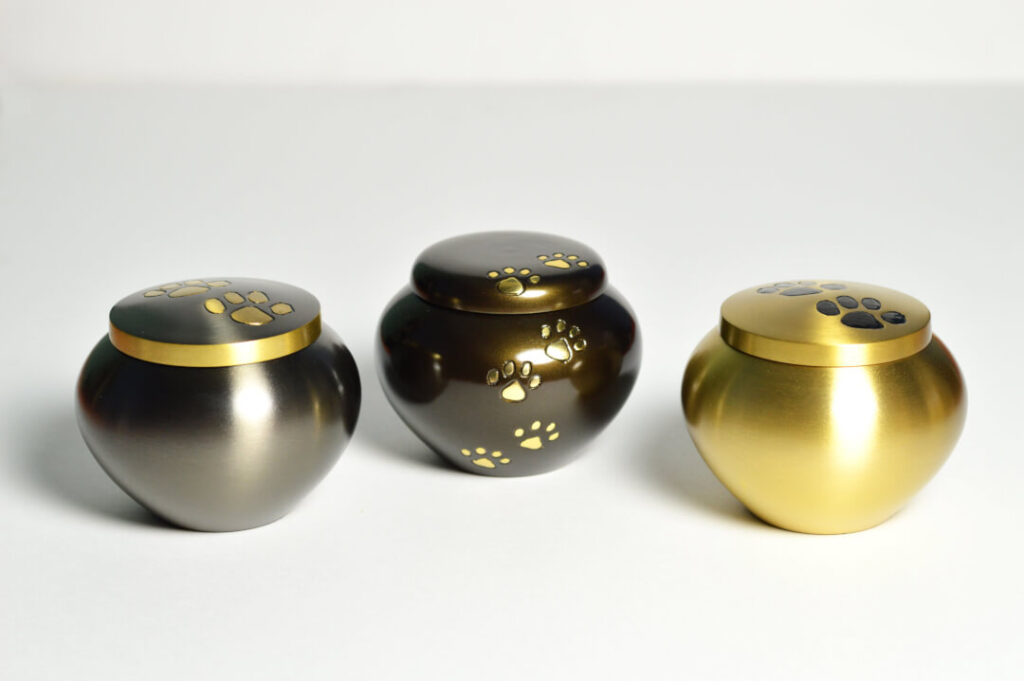
Funeral expenses
There’s a saying “only death is free, but it costs life”.
To know what to expect, you should look into the costs of relevant providers. That way, the overall funeral cost won’t be a surprise.
If this is too expensive, but you would still like to have somewhere to visit and think about your furry friend, you can also reserve a place in an online cemetery and virtually create an individual grave for your pet. No matter how you cope with it, when you say goodbye or afterwards…
Remember your cat as they used to be.
Think of the beautiful moments with them: how you both had fun, how s/he made you laugh, sometimes maybe even cry. If they cheered you up when you were sad, they would certainly do it now, if they were here with you.
The pain and sadness will lessen over the years. But your cat will always have a place in your heart and soul.
